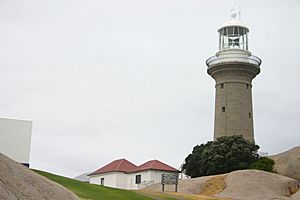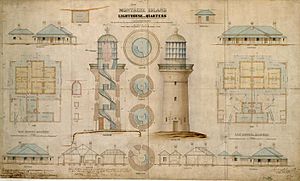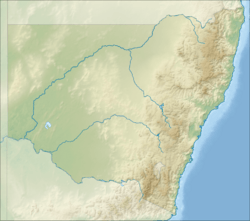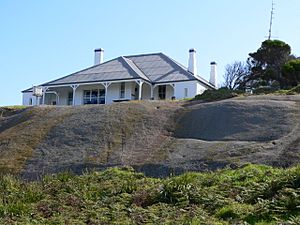Montague Island Light facts for kids
 |
|
| Montague Island Light | |
|
|
|
| Location | Montague Island New South Wales, Australia |
|---|---|
| Coordinates | 36°15′7.15″S 150°13′35.19″E / 36.2519861°S 150.2264417°E |
| Year first constructed | 1881 |
| Automated | 1986 |
| Construction | Granite tower |
| Tower shape | Cylindrical tower with balcony and lantern |
| Markings / pattern | Grey tower, white lantern |
| Height | 69 feet (21 m) |
| Focal height | 262 feet (80 m) |
| Original lens | 1st order Fresnel lens |
| Intensity | 120,000 cd |
| Range | 20 nautical miles (37 km; 23 mi) |
| Characteristic | Fl W 15s. |
| Admiralty number | K2576 |
| NGA number | 111-6568 |
| ARLHS number | AUS-110 |
| Montague Island Lightstation | |
|---|---|

Original plans for the Montague Island lighthouse, 1878.
|
|
| Location | Montague Island, Eurobodalla Shire, New South Wales, Australia |
| Built | 1878–1881 |
| Architect |
|
| Owner | NSW Office of Environment and Heritage |
| Official name: Montague Island Lighthouse, Narooma, NSW, Australia | |
| Type | National heritage (Listed place) |
| Designated | 22 June 2004 |
| Reference no. | 105601 |
| Class | Historic |
| Place File No. | 1/08/271/0006 |
| Official name: Montague Island Lightstation; Montague Island Lightstation and its setting | |
| Type | State heritage (landscape) |
| Designated | 2 April 1999 |
| Reference no. | 1000 |
| Type | Historic Landscape |
| Category | Landscape – Cultural |
| Builders |
|
The Montague Island Light is an active lighthouse on Montague Island. This island is about 9 kilometers (5.6 miles) off the coast of Narooma, Australia. The lighthouse is on the highest point of the island. It was designed by James Barnet and built between 1878 and 1881. The lighthouse is also known as the Montague Island Lightstation. It is a special place listed on the New South Wales State Heritage Register and the Commonwealth Heritage List.
Contents
History of Montague Island
Aboriginal Connections
Montague Island is very important to the Yuin Nation. Two groups, the Walbunja and Djiringanji, have strong ties to the island. They have a creation story about two sons of Gulaga (Mount Dromedary). The younger son became Little Dromedary, and the older son, Barunguba, became the island.
Barunguba was a great place for hunting. People would visit the island in their bark canoes. They hunted birds, collected eggs, and caught penguins and seals. There are old campsites and middens (piles of shells and other waste) on the island. Local groups still use the island for special ceremonies.
European Exploration
In 1770, Captain James Cook sailed past the New South Wales coast. He saw a camel-shaped mountain, which he named Mount Dromedary. Cook did not realize that Montague was a separate island. He thought it was a headland connected to the mainland.
In 1790, the ship Surprise confirmed that Montague was an island. It might have been named after George Montague Dunk, Earl of Halifax. Shipwrecked sailors visited the island several times. During the gold rush in the mid-1800s, people collected seabird eggs from the island. They sold these eggs to miners. As more ships sailed along the coast, people realized a lighthouse was needed on Montague Island.
Building the Lighthouse
Plans for a lighthouse on Montague Island began in 1873. Money was approved in 1877, and building started in 1878. The first builder, J. Musson, had problems and stopped working. In 1880, W. H. Jennings took over and finished the lighthouse early.
The lighthouse was officially lit on November 1, 1881. It used oil and had a light intensity of 45,000 candela. The light flashed in a special pattern. In 1910, 1931, and 1969, the light was made stronger. It was changed from oil to electricity.
The original lens from the lighthouse is now in Narooma. The lighthouse today uses solar power. The lighthouse keepers and their families lived in cottages on the island. They had to grow their own food and raise animals because supplies were hard to get. Communication with the mainland was also difficult.
Life at the Lightstation
The weather often made it hard to deliver supplies and mail to the island. Lighthouse keepers and their families had to be self-sufficient. They had gardens, chickens, cows, goats, and rabbits. They also collected seabird eggs. They relied on boats and simple signals to talk to the mainland.
In the 1890s, people asked for a telephone link to Narooma. A radio was finally provided in 1939. Telephones arrived with electricity in 1950. In 1933, "big game" fishing started near Montague Island.
During World War II, the Royal Australian Navy had a defense facility on the island. The lighthouse buildings were re-roofed in the 1950s. In 1953, the island became a wildlife sanctuary. This made Montague the first official National Trust of Australia property. Scientists also visited the island for research. In 1969, the light was electrified and became much brighter. Lighthouse keepers continued to live and work on the island until 1985.
Automation and Public Access
Lighthouse Automation
In 1987, the lighthouse became fully automated. This meant people no longer needed to live there to operate it. Management of the island was then given to the NSW National Parks and Wildlife Service. The lighthouse tower itself is still run by the Australian Maritime Safety Authority.
The National Parks and Wildlife Service started offering tours to the island. These tours became very popular. In 1990, the island was made a nature reserve. The old lighthouse keeper buildings are now part of this reserve. Public access to the island is now limited to guided tours. These tours are led by National Parks staff and private tour companies.
Original Lens Display
The original Fresnel lens from the lighthouse was last used in 1986. It was carefully taken apart and sent to Sydney for storage. Later, with help from volunteers and donations, the lens was brought back to Narooma. It is now on display at the Lighthouse Museum in Narooma. Visitors can see the lens and its working parts in a 5-meter (16-foot) tower.
Lighthouse Keepers
Many dedicated people worked as lighthouse keepers on Montague Island. Here are some of them:
| Name | Role | Years |
|---|---|---|
| John Burgess | Head | 1881–1898 |
| Charles Townsend | Assistant | 1894 |
| Jock Cameron | Assistant | 1920–1923 |
| Head | 1933–1935 | |
| Tom Paddon | Assistant | 1932–1934 |
| Albert Cottee | Keeper | 1942 – ? |
| Jack Carmody | Head | 1960–1967 |
| Bruce Conley | Head | 1973–1980 |
| John Short | Head | ? – 1986 |
Visiting Montague Island
Access to Montague Island is restricted. You can only visit through guided tours from Narooma. You need to book your tour in advance. It is possible to stay overnight in the old keeper's house. It can host up to 11 people.
Description of the Lightstation
The lighthouse tower is made from granite blocks. These blocks were cut from a quarry right on the island. The tower has a bronze handrail. There are also single-story houses where the lighthouse keepers lived.
Island Setting
Montague Island is about 350 kilometers (217 miles) south of Sydney. It is the largest island close to the New South Wales coast, covering 82 hectares (202 acres). The island has a rugged coastline with steep cliffs, especially on the eastern side. Boats can only land in two sheltered spots on the western side. Getting to the island depends on the sea conditions.
Natural Environment
Montague Island is a Nature Reserve. It is very important for birds, penguins, and fur seals. It is a major breeding ground for seabirds. It also has the most northern colony of Australian fur seals. The island's plants have changed over time due to human activity. Rabbits and weeds are still managed on the island.
Cultural Landscape
On the island, you can find old jetty areas, a boat shed, and former garden sites. There are also graves of a keeper and two children. These graves show how isolated life was for the keepers and their families. Walking tracks connect these different areas. The old garden area still has its fenced enclosure and garden mounds. A well fed by an underground spring was found near the garden.
Other features include the quarry where the granite for the lighthouse was taken. There are also ruins of a Navy hut and old sheds. A special viewing area near the jetty lets visitors watch penguins. A wooden staircase on the eastern side was built by a keeper for fishing. A helipad is also on the island for emergencies.
Lighthouse Buildings
The lighthouse area is high on the southern part of the island. The lighthouse tower stands out from a large granite boulder. It looks beautiful and fits well with the island because it's made from the island's own granite.
The complex includes the lighthouse tower, the keepers' homes, and other storage buildings. Parts of the original flagstaff are still there. The granite quarry is close by. The tower is 12 meters (39 feet) tall and made of dressed granite blocks. It has a curved balustrade (railing) made of gunmetal.
The keepers' homes were built of brick. They had high ceilings and verandahs. The roofs were changed over the years, from iron to tiles, then to asbestos sheets.
Head Keeper's Cottage
The Head Keeper's Cottage is a large building with eight rooms. It has verandahs all around it. A service wing with a kitchen and laundry connects to the main house. There are fireplaces in the main rooms. Inside, you can still see original cedar wood details and built-in cupboards.
Assistant Keeper's Cottages
The Assistant Keeper's Cottages are a duplex, meaning two homes joined together. Each side has four rooms. They also have verandahs and separate service wings. Like the Head Keeper's Cottage, they have fireplaces and original timber floors and cedar details.
Other Structures
Around the lighthouse, there are smaller buildings for storage. These include a brick building (once an oil store, now a generator room) and a weatherboard store. They have hipped roofs made of corrugated steel.
Lantern Equipment
The lantern for the lighthouse was made by Chance Bros in England. It was a "First Order" light, meaning it was very powerful. It first used oil, then electricity in 1950, and finally solar power in 1986.
Condition and Changes
The lighthouse and its buildings are in good condition. The original lens was moved to Narooma for display. Over time, some changes have been made to the buildings. New kitchens and bathrooms were added to the cottages. Verandahs were enclosed. The internal walls were also updated. The solar panels for the light are on the granite boulder near the lighthouse. The old flagstaff is now used as a radio aerial.
In 1993, major repair work was done. This included fixing roofs and gutters, renovating kitchens, and upgrading plumbing.
Why Montague Island Light is Special
Montague Island Lightstation is very important. It combines the natural beauty of a rugged island with the history of a landmark. It shows how coastal shipping developed in the late 1800s.
It is a great example of a lighthouse built in New South Wales in the late 19th century. It was part of a big project to build lighthouses along the coast. It helped protect ships traveling to nearby towns like Narooma, Tathra, and Eden. It is one of only two major lighthouses in New South Wales on offshore islands.
The Montague Lighthouse is beautiful. It is made of granite from the island. Its tapering walls and curved platform show great design and craftsmanship. The white buildings with their chimneys and verandahs look unified on the island's highest point. The homes remind us of the time when people lived and worked at lighthouses.
Montague Island is very special for both its Aboriginal and European history. It is also important for wildlife conservation. It is a Nature Reserve and a research site for scientists. The graves on the island are a sad reminder of the isolated lives of the keepers and their families. The lighthouse was designed by the famous NSW Colonial Architect, James Barnet.
The island is one of the most important seabird breeding areas in New South Wales. It is also the only important resting place for fur seals in the state. Scientists have studied the birds and sea life here for many years. The island is a valuable place to learn about how European settlement affected a natural, isolated environment. There are many archaeological sites on the island, showing its long history.
Montague Island is unique because of its natural values. It is a great example of James Barnet's work as a Colonial Architect.
Images for kids





